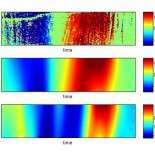Echo of health: Students design noninvasive test for pediatric heart patients

(Medical Xpress)—It has been said that the heart sometimes sees what is invisible to the eye, but thanks to four Rice University mathematics students, the echocardiograms of patients at Texas Children's Hospital (TCH) in Houston may soon reveal something new to the eyes of pediatric cardiologists.
The students, who are each slated to graduate from Rice next month with degrees in computational and applied mathematics, set out last fall to create a computer program that uses noninvasive echocardiograms to give doctors information that currently can be obtained only with an invasive catheter.
The four, who calls themselves "Sgt. Joey's Lonely Hearts Club Band," created the data analysis software for their senior capstone design project, a program requirement for all engineering students at Rice. The team will present its work Thursday at Rice's 2013 Engineering Design Showcase and Poster Competition.
"If someone is already sick, the last thing you want to do is stick things in their heart," said Sgt. Joey's team member Hrothgar of Will Rice College.
"And remember, we're talking about children here," said Guang Yang, another team member from Will Rice. "An invasive catheter is actually a lot worse for them than it would be for adults."
The team's goal is to measure blood pressure gradients inside the heart. They were assigned the task after TCH cardiologists brought the problem to the attention of faculty in Rice's Department of Computational and Applied Mathematics (CAAM).

The pressure gradient is a dynamic measure that tells doctors how powerfully the heart is pumping blood. The pressure gradient within the left ventricle—the final chamber that blood passes through before it leaves the heart—is a particularly useful measure for cardiologists.
Physicians today can only reliably measure the pressure gradient in the left ventricle with a catheter, a thin probe that must be threaded through a patient's blood vessels and placed inside the ventricle while the heart is beating.
Sgt. Joey's team member Joey Huchette of Martel College said the team's assignment was to find a way to measure the gradient using the data from echocardiograms, noninvasive heart tests that involve technology similar to that used for sonograms.
"Heart patients at Texas Children's undergo echocardiograms regularly anyway, and they are noninvasive," Huchette said. "Doctors can use the echocardiogram to extract information about the velocity of the blood in the heart. This test tells them how fast the blood is moving toward the probe, and that's useful, but it's not as useful as the pressure information is in certain contexts.
"We're trying to find if there's a way that we can turn this readily available information about the velocity of the blood in the heart into this pressure information that is useful diagnostically," Huchette said.
Andrew Tilley, a team member from Hanzsen College, said, "Our starting point is the echocardiogram picture, which is basically an array of velocity values. At each pixel, we're trying to convert velocity to pressure."
The team found that there were various well-studied equations from fluid dynamics that they could use to attack the problem, and they even found previous studies where doctors had worked out some details of the conversion. However, the equations were very complex, and it took several months to determine whether their goal of using the echocardiogram data was even feasible.
By Christmas break, the team had worked out the mathematical framework after several meetings with Dr. Elijah Bolin, a third-year fellow in cardiology at TCH; Dr. Craig Rusin, assistant professor of cardiology at TCH; and Dr. Daniel Penny, chief of cardiology at TCH. They are currently trying to validate their model with data from a daylong test at TCH using an invasive catheter in a mechanical heart.
They've also logged hundreds of hours creating and refining their software, which was designed for a user with basic computer skills and a typical PC. The software also needs to deliver results in a visual format that is both useful to cardiologists and easy to interpret in a matter of seconds.
Sgt. Joey's Lonely Heart's Club Band is still working on its project and plan on handing it off to another design team next year. They hope the design can be refined to the point where researchers in Penny's lab can test the software in an animal model in a side-by-side comparison with catheters.
"Hopefully, it can help people down the line at some point," Tilley said. "That possibility is one of the things that made this project interesting to work on."

















